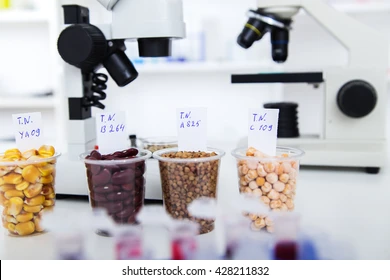
Originally, the most extensive information about the composition of foods was based on a system of analysis described as the proximate analysis of foods, which was devised over 100 years ago by two German scientists, Henneberg and Stohmann.
More recently, new analytical techniques have been introduced, and the information about food composition is rapidly expanding (see below). However, the system of proximate analysis still forms the basis for the statutory declaration of the composition of foods in Europe.
Proximate Analysis of Foods
This system of analysis divides the food into six fractions:
- Moisture
- Ash
- Crude protein
- Ether extract
- Crude fibre
- Nitrogen-free extractives
Moisture Content
The moisture content is determined as the loss in weight that results from drying a known weight of food to constant weight at 100 °C.
This method is satisfactory for most foods, but with a few, such as silage, significant losses of volatile material (short-chain fatty acids and alcohols) may take place.
Therefore, for silages, the moisture content can be determined directly by distilling the water from the sample under toluene.
The distillate is measured and corrected for the presence of fermentation acids and alcohols.
Ash Content
The ash content is determined by ignition of a known weight of the food at 550 °C until all carbon has been removed.
- The residue is the ash and is taken to represent the inorganic constituents of the food.
- The major component of ash is silica, but ash may contain material of organic origin such as sulphur and phosphorus from proteins.
- Some loss of volatile material (e.g., sodium, chloride, potassium, phosphorus, sulphur) takes place during ignition.
Thus, the ash content is not truly representative of the inorganic material in the food either qualitatively or quantitatively.
Animals do not require ash per se, but require the individual mineral elements that it contains, determined by methods such as atomic absorption spectrometry (see p. 12).
Crude Protein (CP) Content
The CP content is calculated from the nitrogen content of the food, determined by a modified Kjeldahl method:
- The food is digested with sulphuric acid, which converts all nitrogen (except nitrate and nitrite) to ammonia.
- Sodium hydroxide is added to the digest to liberate the ammonia.
- Ammonia is distilled off and collected in standard acid, then quantified by titration or an automated colorimetric method.
It is assumed that nitrogen comes from protein containing 16% nitrogen, so nitrogen is multiplied by 6.25 (i.e. 100/16) to estimate protein.
This is not true protein, as it includes nitrogen from non-protein sources like free amino acids, amines, and nucleic acids, so the term crude protein is used.
Ether Extract (EE) Fraction
This is determined by continuous extraction of food with petroleum ether for a defined period.
- The residue, after evaporation of the solvent, is the ether extract.
- It contains lipids, as well as organic acids, alcohols, and pigments.
This is referred to as method A.
In the current official method, the ether extraction is preceded by hydrolysis with sulphuric acid — the resulting residue is the acid ether extract (method B).
Carbohydrate Fractions
Carbohydrates are divided into:
- Crude Fibre (CF)
- Nitrogen-Free Extractives (NFE)
Crude Fibre
Determined by treating the residual food (after ether extraction) with boiling acid and alkali of defined concentration.
- The organic residue is the crude fibre.
- Contains cellulose, lignin, and hemicelluloses, but not necessarily all of these present in the food.
A variable proportion of the cell wall material, depending on species and growth stage of the plant, is dissolved during crude fibre extraction and ends up in the nitrogen-free extractives.
This results in:
- Underestimation of fibre
- Overestimation of starch and sugars
Nitrogen-Free Extractives (NFE)
This is calculated as:
1000 – (moisture + ash + crude protein + ether extract + crude fibre)
The NFE fraction is a heterogeneous mixture of all components not measured in other fractions.
Includes:
- Starch
- Sugars
- Fructans
- Pectins
- Organic acids
- Pigments
- Plus components from partially dissolved cell wall material


https://myteana.ru/forums/index.php?autocom=gallery&req=si&img=6617